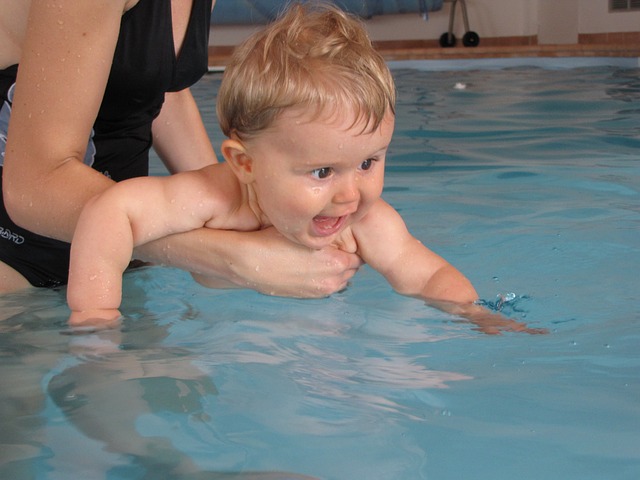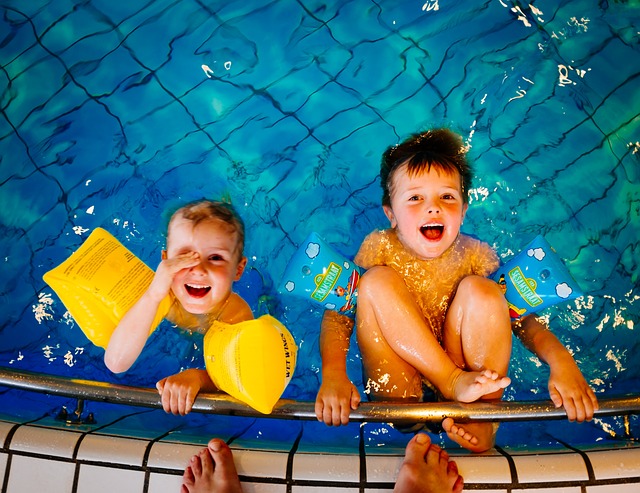Children and Water: Age by Age Swimming Safety Strategies for Parents and Caregivers
Children and water do mix, but you have to mix them in a very particular way. Here’s how to teach them how to swim, respect the waves, and how to keep them safe, always.

For Children Under 1:
Children under 1 year don’t need to be swimming – not in the usual sense. Rather, this is a good time to introduce your baby to the water. And, only do this at 6 months of age or older. The goal at this age is to get them acclimated to the idea of being in water. Encourage your baby to have fun by playing games with them.
Most children love playing in water, and will splash and laugh, bobbing up and down while in your arms.
Keep them in shallow water. You only need an inch or two – just enough to get them wet. They won’t know the difference between a shallow inflatable pool and the ocean, and the small inflatable pool is much, much, safer.
You should never submerge your baby’s head under water because they might ingest a surprisingly large amount of water. This could choke them.
Never leave your baby unattended in or around any pool or body of water of any size. It only takes an inch of water to drown a baby and it can happen in under 30 seconds.
Children 2-3 Years:
By the time your child is between 2 and 3 years old, they will probably have developed an intense curiosity about the water and will want to become more avid swimmers. This is a time when you can put your child into slightly deeper water – probably an inflatable pool that’s filled up all the way.
Play games with your child, let them float on your arms while they kick their legs, try to paddle with their arms, and move. Teach them how to blow bubbles in the water so they learn how to get their face wet without swallowing water.
According to SwimEasy, your child is still at risk for drowning at this age, so you need to supervise him or her at all times. Children are especially daring now, and may try to go in the pool without you, or might want to break free and try to swim on their own.
Even though your toddler might feel more comfortable in the water, you can’t let them alone – not for a second.
Don’t rely on inflatable vests or swimming aids, like water wings or other inflatable gear, as these are not reliable as flotation devices or life preservers.
They provide a false sense of security, can deflate while in use, and may result in drowning. This is the age where you want to stress water safety. Specifically, you want to make sure your child understands:
- Never dive into a shallow pool.
- Never go into a pool without an adult there to watch.
- Never go in after a pet that has gone into a pool, even if the pet is in danger. Get an adult instead.
- Never try to help someone, get an adult instead.

Children 4-5 Years:
By the time your children are 4 or 5 years of age, it’s tempting to let them be out in the water on their own, but this is when you really need to be with them. Your child is beginning to develop proper coordination necessary for self-swimming.
You can send them to an instructor for formal swimming lessons, but they should be supervised lessons by a certified swimming instructor. Lessons will teach your child how to float by themselves, submerge their face underwater for five to ten seconds, and also use coordinated kicking and arm movements.
Your child might even learn several swimming strokes, like the backstroke, the breaststroke, and the side stroke. Most instructors will also teach children how to tread water and do a doggy paddle as these are some of the easiest strokes and moves to do that could save the child’s life one day.
Some things to be on the lookout for:
While your child is becoming a better swimmer, they’re no expert yet. You should practice distant supervision – be within arms reach of your child at all times.
Children 6 and Up:
For children 6 and up, your child should be able to hold their breath underwater for longer periods of time. Some children can hold their breath for several seconds, and even swim across a small pool. They may also know how to jump into the water and resurface on their own.
This is also the time when they will have gotten really good with their swimming and may even become a better swimmer than you.
Even so, your child should still be supervised. Make sure all diving is done only in the deep end of the pool and be mindful of your child’s skills in the pool. They don’t always translate to larger bodies of water.
For instance, many parents are surprised to learn that their children can’t swim as well in the ocean as a pool. This is due, in large part, to the waves and current in the ocean. Powerful undertow can sweep your children out into the water, so you must always keep an eye on them and, if possible, swim with several adults who are excellent swimmers.
Gail Smith is the managing director of SwimEasy, one of Scotland’s leading swimming lesson providers. Several SwimEasy graduates have gone on to compete at both national and international level, including Craig Hamilton, Craig McNally and her own son Lewis Smith. Before running her own company, Gail was a swimming coach at Warrender Baths Club at Development and Age Group Standards.













